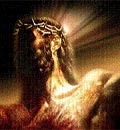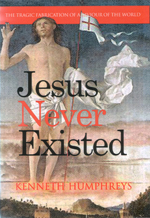
In the Mind's Eye
" Virtually all the commentators ... simply cannot cut the emotional umbilical cord tying them to the idealistic image of the Nazarene Jesus they have created in their minds."
– N. Carter (The Christ Myth, 183)
A Professor Speaks..
"Love of God and of our neighbour. This pairing of the two ordinances in absolute priority over all the other injunctions occurs elsewhere in Jewish thought after the Old Testament and may not, therefore, be Jesus' original invention."
– Michael Grant, Jesus, p27.
Wild John
The Christian evangelists set out to diminish the stature of John the Baptist by assigning him a minor role in their own fabricated saga.
The charismatic preacher was turned into a mere herald of Jesus, an "Elijah" foretelling of their godman, just as the ancient oracles required.
Every gospel reference to John is coupled with a put-down or confession of subordination.
But wild John the Baptist could NOT have been a mere herald of Jesus.
His sect would not have continued if, in reality, he had so readily deferred to a superior holy man (his same-age cousin to boot).
Followers of John existed for centuries, despite the triumph of Christ, some becoming Mandaeans.
Flying Pigs?
Ancient Gadara
Transformer

The "Transfiguration" into brilliance established JC as quintessentially "pure" and "perfect."
The supporting roles given to Moses (prototype Law-giver) and Elijah (prototype Prophet), summoned up from Heaven at this point, served to elevate the superhero even higher.
The theological/political purpose was not merely to raise the godman but to subordinate the "returned Elijah" John the Baptist.
Although the disciple John is supposedly a human witness to this wondrous event he "forgot" to mention it in his gospel!
Hellenized Judaism in the cities of the eastern Mediterranean fused a multiplicity of themes – Wisdom, Logos, Son of God, Son of Man, Redemptive Sacrifice and Messiah – into a universal saviour God. The farrago made little headway against rabbinic Judaism – but among pagans disillusioned with their arbitrary traditional gods, the mix found a following. Nowhere in the saga does a genuine human life emerge. Every instance in the godman's career is a set-piece, templated from an earlier source. And the "character" of Jesus who emerges from all this is neither a paragon of virtue nor a simple philosopher – but then how could he be, assembled as he is from the works of many hands over generations of pious reflection? "That Scripture Might Be Fulfilled" The earliest works on the Christian godman were simple documents designed for liturgical use. The figure of Jesus had no discernible features, no true biography – merely attributes befitting his messianic status, such as absolute assuredness and "authority" and the concomitant display of anger, irritation and pity of one who expects to be obeyed. Each worthy
tenet of a higher morality, every pithy statement of priestly wisdom,
was coupled to the majestic name to give sanction and assurance
of its heavenly origin.
The compendium that resulted – ambiguous, inconsistent, improbable and impossible – though never intended as a "history", none the less masqueraded as such, underpinning the claims of the faith to a unique historical foundation. But any attempt to reconstruct the timetable or itinerary of the "ministry" of the Christian saviour is doomed to failure because the gospels are both inadequate and contradictory. One moment Jesus is in the Decapolis, receiving word of the death of John the Baptist, the next he is in Phoenicia expelling demons. One moment Jesus is "transfiguring" on a mountain in Syria, the next he is pontificating in Samaria.
The micro-stories (pericopes) of the gospels had a life of their own. Thus the fig tree of Jewish scripture, symbolic of the abundance of the Torah itself (Mishlei 27.18), becomes in Luke (13.6,9) a Jesus parable in which a fig tree does not bear fruit, though patience is urged (Come on Jews!). Then in Matthew (21.19) the parable is finessed into a Jesus miracle in which he summarily curses a fig tree (Too late, Jews!). The wisdom statements, parables and miracles, all have their origin other than in a walking, talking guru/Son of God.
Nowhere in the Gospels is there a genuine two-way dialogue in which the Jesus character actually responds in an authentic manner to his audience. Their comments serve merely as entrees for his obtuse parables, epithets of wisdom and sage advice. He walks, he talks, he moves on. He does not solicit genuine questions, he makes no asides or humorous quips. He never greets anyone in a friendly or familiar fashion. He refers nowhere to contemporary events (the death and deification of Emperor Augustus was surely worth a mention?) nor does he recall incidents from his own life. The fabricated hero has all the personality of a vending machine dispensing pre-packed gems of divine erudition.
Histrionics "Cleansing of the Temple"? Nothing more than a midrashic revamp of Zechariah's "in that day there shall be no more a trafficker in the house of the Lord" (14.21) and Hosea's "for the wickedness of their doings I will drive them out of mine house" (9.15). "Feeding of the Multitude"? The source is 2 Kings 4.42,44, a yarn in which the new man Elisha, with double strength holy spirit, improves upon Elijah, his mentor's miraculous feeding of a mere one hundred men. The structure of this story is identical to the feeding of the 4000 (and the 5000!), even including small details, such as left-overs and expressions of doubt. In the supposed "trial" of the godman, the exchange between the high priest Caiaphas and Jesus (Matthew 26.63,64; Mark 14.61,62) is clearly a contrived juxtapositioning, cross-associating "Messiah", "Son of God", "Son of Man" and Daniel's "coming in the clouds of heaven” (7:13) into one pithy mission statement.
Miracle Making Paul's epistles and Mark 8 indicate that no Jesus miracles were circulating in the earliest Christian preaching. The miracles that pepper the Gospels, and helped elevate a Jesus figure into a deity, are nowhere to be found in Paul’s letters. But competition in the sanctity business soon made "signs and wonders" a necessary ingredient. Midrashic revision of Jewish scripture and the adaptation of Hellenistic legends rapidly made good the inadequacy. The Transfiguration of Jesus on the mountain top of Mark 9.1,13 actually forged a link between the Christian hero and Israel's two earlier prophets, Moses and Elijah (Elias). They appear and "talk with Jesus" (what about, one wonders?). The purpose of this bizarre episode? It serves to make clear who is top dog in this assemblage of all-time greats. God himself booms out "This is my beloved Son. Hear him!" The whole incident is staged before conveniently present "human witnesses" Peter, James, and John. On the way down from the mountain top Jesus tells his adoring groupies that "Elias is indeed come", a cryptic but rather nice way of belittling both Elias and his supposed alter ego, John the Baptist. When the author of Matthew comes to copy Mark's little story he actually inserts an extra line at this point, just to make the message crystal clear:
Flying Pigs In the miracle of the Gadareen swine Jesus expels a horde of demons from a man possessed into a grazing herd of pigs. The swine "ran violently down the steep place into the sea, about two thousand of them; and drowned" (Mark 5.13). Not only is Gadara 7 miles from the Sea of Galilee, it sits at an elevation of 1200 feet.. To reach the sea (aka Lake Tiberias) one has to descend into the ravine of the Yarmuk River, cross this major tributary of the Jordan and scale the Golan Heights (2000 feet). True, the Gospels refer not to the city but to the "land of the Gadarenes". But Luke clarifies:
The 6th Legion Ferrata ('ironclad') had been deployed in suppressing Jewish rebels throughout the 1st century. After the final defeat of the Bar Kosiba rebellion in 136, it's legionary base was transferred to Caparcotna (Megiddo) in Galilee, known thereafter as Legio – and is still known today as el-Lejjun. Legio is 25 miles from Gadara.
A Saviour from on High – From Neo-Essenes to Para-Christians The last gasp of militant Judaism came with the defeat of Bar Kochba in 135 and with it hopes of a human saviour. With the military debacle, a new generation of the 'pious right' again looked back to an earlier time and to the heavens for salvation. At their foundation the Essenes had rejected the polluting influences of Greece and Rome. They had taken a prominent role in the armed resistance but the debacle of 68-70 meant that the centre of gravity of their movement shifted to communities in the diaspora. Over the next seventy years their xenophobic attitudes softened. In Palestine itself remnants of the Essenes fractured, with a minority element clinging to fading traditions of their human founder and drawing closer towards traditional Judaism. Some would take on a new life in the 2nd century as Ebionites. Others returned to memories of a more recent hero, a baptizing eccentric called John. In the Jewish communities of the eastern cities (notably, the "seven churches of Asia") the Hellenized Jews were the target of many shades of charlatanism. Gnostic notions, particularly Paul's concept of a divine Christ, influenced certain groups of who began calling themselves the 'Church of God'. The long dead Teacher of Righteousness of the Essenes had been accorded, retrospectively, the holy mantle of Messiah and given the name of Yeshua in honour of the original successor of Moses. He now waited in Heaven, until God realized his kingdom on earth. The Kingdom of God movement had a core of itinerant prophets, supported by a more extensive laity of “householders” who gave them food and lodging and followed a less extreme commitment to the movement’s principles. At this stage the Christian prophets began projecting their messiah personally into an eschatological future – the imminent End of Days – and with a very specific purpose in mind. His new, celestial role was to "judge the quick and the dead", a task formerly taken by God himself. At the same time,
the fabrication – from scripture – of an earthly
life for
their hero continued in earnest.
Paradoxically, the faithful interpret the disparities, puzzling omissions and flat contradictions in the life of their saviour as "evidence of its truth." That it is actually an eclectic assemblage of various prototypes never enters their consciousness. No wonder there are a thousand different Jesuses – only a void can support simultaneously such a plethora of speculation. The truth is simpler: Jesus never existed.
Sources:
'Save' a friend e-mail this page
Copyright © 2005
by Kenneth Humphreys.
|
||||||||||||||||||||||||||||||||||||||||||||||||||||||||||






